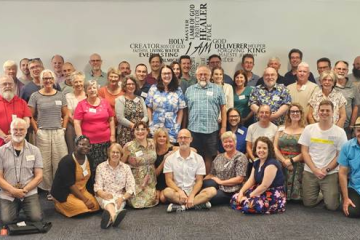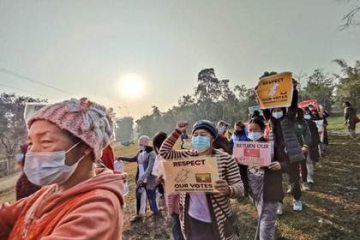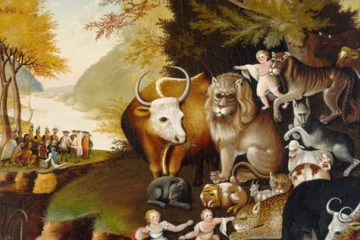Today we are marking an important moment in the life of this church – our decision, on the 26th November 2023, to seek affiliation with the Open Baptists, and our admission into that association on the 25th May this year.
It’s a moment that resonates with this reading from 1 Kings 8, which is, for now, where we will leave this saga of the Israelite kings. Because we, too, are remembering all the work that has brought us here. We, too, are filled with thankfulness for how God has led us in the past. We are aware that the presence of the Lord is moving in this place. And we, too, want to pray, as Solomon prayed, that God will continue to be faithful to us, and we will continue to be faithful to God.
I’ve also been reading up on CBC history this week (thanks to the excellent materials produced by Valerie Spear, Bill Hughes, Russell Holly and Ron Robb) and can also see similarities between this reading and the opening of this church, 23-24 February 1929.
This building is not as grand as a temple, perhaps. Many of you will know that in the original designs by architect Frank Peplow this building was to be the Sunday School Hall, built alongside a grand Baptist ‘cathedral’ and other buildings. But as the fundraising efforts and construction took place on the eve of the Great Depression – the completion of this building was (and is) a significant achievement.
And, like the dedication of the temple, the opening of this building attracted leaders – leaders of the Baptist churches around Australia, representatives from other denominations, politicians, officials and local Baptists and supporters.
1 Kings 8 is also full of reminders of God’s faithfulness to the people in the past. The cloud that fills the temple is the same cloud that led the people out of Egypt (Exodus 13:21-22), descended on Mount Sinai when they received the Law (Exodus 24:15-18) and settled on the ark of the covenant, the sign of God’s presence, during their time in the wilderness (Exodus 40:34-38). And this church, too, is full of reminders of God’s faithfulness – memorials to those who played a significant part in Baptist life here and elsewhere. They are, as Hebrews 12: 1 says, are the “cloud of witnesses” that continues to walk with us as we seek to walk in God’s way.
And there was also, in 1929, at the opening, a strong sense of the presence of God. Rev A J Waldock, the first minister writes, “Nearly a year was to pass before the building was ready for occupation. But at last, the long-anticipated day arrived and on 23 and 24 February 1929 the beautiful sanctuary, the visible token of the unity and devotion of the Baptist people of Australia was opened for public worship. It would be impossible to translate into cold print the atmosphere and spiritual emotion that marked the occasion!”
And just as Solomon dedicated the temple with prayer, this church was dedicated with prayer, from the opening ceremony, at 3pm on the Saturday, where the President of the Baptist Union of Australia, Rev J H Goble, opened the door of the church with a gold key (this gold key that Barbara Coe was able, recently, to rediscover), to the closing service, 7:30pm on Sunday, preached by Rev A J Waldock.
I didn’t include all of Solomon’s prayer in our reading this morning (it continues for another 22 verses), but I am struck by how contemporary – how relevant for us today – this prayer is. It develops in verses 31 to 53 into a series of different petitions.
Firstly, for our personal relationships, that when we ‘sin against our neighbours’ (verse 31), when we wound one another, we will ask God’s forgiveness and seek to make things right. This would be our prayer, our hope, for how we relate to one another in this church.
Secondly, that when we do wrong as a community (verse 33) – there is no promise of a perfect community here – but a community that can acknowledge when it goes wrong and again ask God’s forgiveness; that strives to live in peace with others.
Thirdly, that when there is drought – environmental and economic disaster – because of our sin (verse 35 & 36) we will confess and be shown “the good way that we should walk”. Perhaps this sounds like a very archaic theology, but it is challengingly relevant to our understanding of anthropogenic climate change.
Fourthly, there is a prayer for all the different hardships and heartbreaks human beings experience – famine, plague, blight, mildew, locust or caterpillar, enemy, sickness – “whatever prayer, whatever plea there is from any individual or from all your people Israel” (verse 38) that God will hear, forgive, act and render justice and compassion.
But there is another dimension to this prayer, and to our thinking about the history and current ministry of this church – and that is where our focus has been? Has it been internal – directed mostly at our life together – or has also been external – looking to see how God is moving in mission beyond these brick walls?
When I was at uni, the most fascinating anthropology lecture I remember was about the impact – psychologically and theologically – of the changes made by Vatican II in the Catholic Church – specifically about the change that took place when the priest, rather than facing the altar during the mass, was turned around to face the people.
There were good reasons for the change. It was a powerful way of communicating God’s immanence, that God is here among us – with us – as we gather and minister to one another. It was an important psychological and theological reorientation for the Catholic church.
But there is something very powerful about the first orientation as well. It reminds us, as Solomon’s prayer does, that God is transcendent; that although the temple was a place where ‘God’s name was present’ nothing in heaven or on earth could actually contain God. Verse 27; “Will God indeed dwell on the earth? Even heaven and the highest heaven cannot contain you, much less this house that I have built!”
And this is what we see in Solomon’s physical orientation in this passage. He goes with the leaders of Israel to bring the ark of the covenant of the Lord to its new resting place (verse 1), he then turns around (verse 14) to bless the people, and then turns back around (verse 22), stands before the altar in the presence of the whole assembly, and prays.
And because of Solomon’s posture – his re-orientation that emphasises God’s transcendence – God’s otherness – God’s out-there-ness – there are two further petitions here.
In the fifth petition Solomon prays for foreigners, for people who are not Israelites or even residents of Israel, for people who come from countries far away and he asks God to also hear them! The understanding that God cannot be contained, the orientation to God’s otherness, leads to the radical conclusion that God is not only Israel’s God, but the God of all people who would come and worship.
And furthermore, in the sixth petition, a prayer that shows that this material was worked on and edited when the people were taken away into captivity in Babylon, we have Solomon saying that even when they cannot be in this special place, God will be with them because the uncontainable God is to be found everywhere! Verse 52 “Let your eyes be open to the plea of your servant, and to the plea of you people Israel, listening to them whenever (wherever!) they call to you.”
We have often contrasted this image, of the opening of the church, with more recent images of the church. There are wonderful reasons for us to focus inwards at times, to be shaped by our understanding by God’s immanence, God’s presence among us. But we are also a church that is being shaped by our understanding of God’s transcendence, by the knowledge we cannot contain or restrain God’s love, that our denomination cannot contain or restrain God’s love, that – as Baptists have often said – “the Lord hath more truth yet to break forth out of his Holy Word”, that good news of Jesus is for all people without qualification, and that like Solomon’s prayer, we want to create a community of genuine welcome.
It is for all these reasons that we celebrate today being part of the Open Baptists.
Just as Solomon prayed at that celebration that God would be with them, that they would continue to walk in God’s way, we want to pray that prayer today as well. So this morning I want to invite all of you to write prayers – just one line or one phrase – that we can add to our prayers of intercession – in any of these six categories:
- prayers for our personal relationships
- prayers for peace in our community and world
- prayers for our environment
- prayers for those who are sick or suffering
- and also prayers for the mission of this church that it will continue to acknowledge that God has other children, and that God calls us to go beyond the walls of this church – and to offer to those who come a genuine welcome.
As we sing the next hymn…I invite you to write and to bring those prayers.


